Around the World
March/April 2024
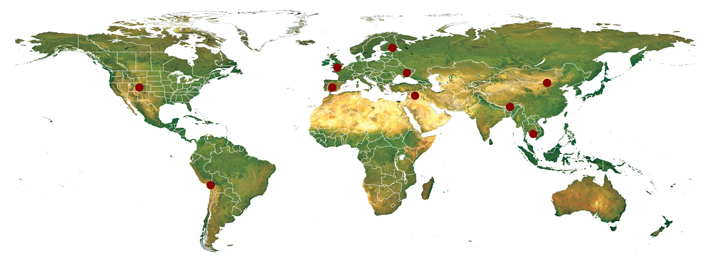

-
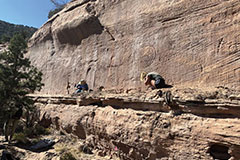 COLORADO: Archaeologists have recorded rock art high above Castle Rock Pueblo on the Mesa Verde Plateau. The petroglyphs were found in a cliffside location 2,400 feet above houses built into a canyon wall. The oldest petroglyphs date to the 3rd century A.D., while most were created in the 12th and 13th centuries. The panels include geometric figures that the Pueblo people may have used to record astronomical observations or to denote specific days of the year.
COLORADO: Archaeologists have recorded rock art high above Castle Rock Pueblo on the Mesa Verde Plateau. The petroglyphs were found in a cliffside location 2,400 feet above houses built into a canyon wall. The oldest petroglyphs date to the 3rd century A.D., while most were created in the 12th and 13th centuries. The panels include geometric figures that the Pueblo people may have used to record astronomical observations or to denote specific days of the year. -
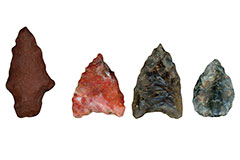 PERU: Settlement in the high-altitude Lake Titicaca Basin may have been greatly aided by the development of bow-and-arrow technology. Researchers recently analyzed more than 1,000 projectile points manufactured over a period of 10,000 years beginning in 9000 B.C. They determined that around 5,000 years ago, points became decidedly lighter and smaller, likely coinciding with the transition from thrown spears to bow-fired arrows. This allowed people to hunt smaller, faster prey. It is the oldest evidence of archery in the Americas.
PERU: Settlement in the high-altitude Lake Titicaca Basin may have been greatly aided by the development of bow-and-arrow technology. Researchers recently analyzed more than 1,000 projectile points manufactured over a period of 10,000 years beginning in 9000 B.C. They determined that around 5,000 years ago, points became decidedly lighter and smaller, likely coinciding with the transition from thrown spears to bow-fired arrows. This allowed people to hunt smaller, faster prey. It is the oldest evidence of archery in the Americas. -
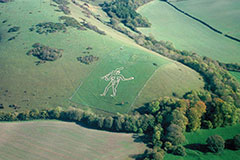 ENGLAND: The Cerne Abbas Giant has towered over the Dorset countryside for centuries, yet experts continue to debate when and why the 180-foot-tall figure was carved into the chalky hillside. New evidence indicates the giant was created between A.D. 700 and 1100. Scholars also now suggest it depicts the semidivine hero Hercules with a club in his right hand and that his characteristic lion skin was once shown draped over his left arm. The widely visible site was probably used as a muster station for Saxon armies assembled to fend off invading Vikings.
ENGLAND: The Cerne Abbas Giant has towered over the Dorset countryside for centuries, yet experts continue to debate when and why the 180-foot-tall figure was carved into the chalky hillside. New evidence indicates the giant was created between A.D. 700 and 1100. Scholars also now suggest it depicts the semidivine hero Hercules with a club in his right hand and that his characteristic lion skin was once shown draped over his left arm. The widely visible site was probably used as a muster station for Saxon armies assembled to fend off invading Vikings. -
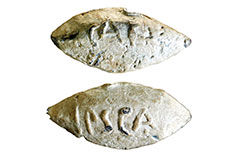 SPAIN: Before Julius Caesar seized control of Rome, he won a particularly contentious civil war against another renowned general, Pompey the Great. Their final battle occurred in 45 B.C. in the province of Hispania. A 1.7-inch-long lead shot recently found in the town of Montilla is a relic of the contest. The sling projectile is inscribed with Caesar’s name (“CAES”) on one side and the place name “IPSCA” on the other. The shot likely belonged to a soldier from the Iberian town of Ipsca who had joined Caesar’s cause.
SPAIN: Before Julius Caesar seized control of Rome, he won a particularly contentious civil war against another renowned general, Pompey the Great. Their final battle occurred in 45 B.C. in the province of Hispania. A 1.7-inch-long lead shot recently found in the town of Montilla is a relic of the contest. The sling projectile is inscribed with Caesar’s name (“CAES”) on one side and the place name “IPSCA” on the other. The shot likely belonged to a soldier from the Iberian town of Ipsca who had joined Caesar’s cause. -
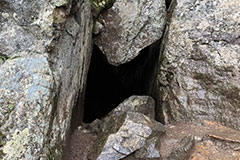 FINLAND: A cave in the Koli Mountains known as Devil’s Church has long been associated with the supernatural. It’s said that local shamans, most famously an 18th- or 19th-century sage named Kinolainen, communicated with the spirit world, performed magic rituals, and healed the sick in the cave. A new archaeoacoustic study revealed that the 110-foot-long crevice has a unique shape that makes sounds—particularly those created by clapping, stomping, and chanting—louder and longer lasting at certain frequencies.
FINLAND: A cave in the Koli Mountains known as Devil’s Church has long been associated with the supernatural. It’s said that local shamans, most famously an 18th- or 19th-century sage named Kinolainen, communicated with the spirit world, performed magic rituals, and healed the sick in the cave. A new archaeoacoustic study revealed that the 110-foot-long crevice has a unique shape that makes sounds—particularly those created by clapping, stomping, and chanting—louder and longer lasting at certain frequencies. -
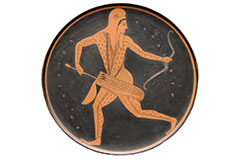 UKRAINE: Nomadic Scythians who rode across the Eurasian steppe in the first millennium B.C. were renowned for their horsemanship—and their savagery. According to the Greek historian Herodotus, Scythian warriors drank their enemies’ blood and, occasionally, used their skin to cover quivers. Analysis of leather preserved at 14 sites near the Black Sea indicates that the Scythians did indeed make leather for quivers from human skin in at least 2 cases, confirming Herodotus’ grisly tale.
UKRAINE: Nomadic Scythians who rode across the Eurasian steppe in the first millennium B.C. were renowned for their horsemanship—and their savagery. According to the Greek historian Herodotus, Scythian warriors drank their enemies’ blood and, occasionally, used their skin to cover quivers. Analysis of leather preserved at 14 sites near the Black Sea indicates that the Scythians did indeed make leather for quivers from human skin in at least 2 cases, confirming Herodotus’ grisly tale. -
 TIBET: Without yaks, which provided an essential source of meat, milk, and transportation, humans would have struggled mightily to sustain themselves in the harsh conditions of Himalayan mountain valleys. However, until recently it was not known when yaks were first domesticated. Sequencing of DNA from animal bones found at the site of Bangga, one of the earliest agropastoral settlements on the southern Tibetan Plateau, has revealed that yak domestication occurred at least 2,500 years ago.
TIBET: Without yaks, which provided an essential source of meat, milk, and transportation, humans would have struggled mightily to sustain themselves in the harsh conditions of Himalayan mountain valleys. However, until recently it was not known when yaks were first domesticated. Sequencing of DNA from animal bones found at the site of Bangga, one of the earliest agropastoral settlements on the southern Tibetan Plateau, has revealed that yak domestication occurred at least 2,500 years ago. -
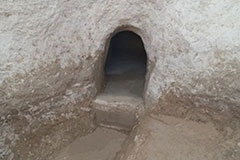 CHINA: Some 4,300 years ago, Houchengzui, located in the Inner Mongolia Autonomous Region, was the Fort Knox of its day. The 341-acre site was surrounded by 3 sets of massive stone walls replete with gates and guard towers, making it one of the most heavily defended cities of the Longshan era (ca. 3000–1900 B.C.). New discoveries show that this defensive network was supplemented by a warren of tunnels radiating from the city center that facilitated stealthy communication and transport throughout Houchengzui.
CHINA: Some 4,300 years ago, Houchengzui, located in the Inner Mongolia Autonomous Region, was the Fort Knox of its day. The 341-acre site was surrounded by 3 sets of massive stone walls replete with gates and guard towers, making it one of the most heavily defended cities of the Longshan era (ca. 3000–1900 B.C.). New discoveries show that this defensive network was supplemented by a warren of tunnels radiating from the city center that facilitated stealthy communication and transport throughout Houchengzui. -
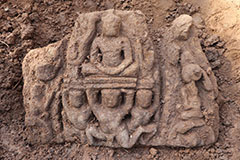 CAMBODIA: A restoration team working in Angkor Archaeological Park recovered 6 sandstone statues beneath the southern gate of Ta Prohm Temple, a monastery and center of learning that once housed 12,500 people. The statues depict Buddha being sheltered by Naga, a protective serpent, and Avalokiteshvara, a bodhisattva. The artworks date to the 12th or 13th century, during the reign of Jayavarman VII (reigned 1181–1218), the first Khmer king to adopt Buddhism. During his rule, the king embarked upon a massive building campaign that included Ta Prohm.
CAMBODIA: A restoration team working in Angkor Archaeological Park recovered 6 sandstone statues beneath the southern gate of Ta Prohm Temple, a monastery and center of learning that once housed 12,500 people. The statues depict Buddha being sheltered by Naga, a protective serpent, and Avalokiteshvara, a bodhisattva. The artworks date to the 12th or 13th century, during the reign of Jayavarman VII (reigned 1181–1218), the first Khmer king to adopt Buddhism. During his rule, the king embarked upon a massive building campaign that included Ta Prohm. -
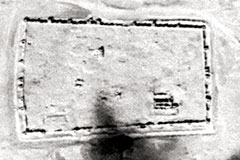 SYRIA: Although its dominion over Europe is likely better known, the Roman Empire also held sway over much of the Near East. The emperors Septimius Severus (reigned A.D. 193–211) and Diocletian (reigned A.D. 284–305) invested heavily in infrastructure along the empire’s eastern borders. Satellite photographs revealed 396 previously unknown Roman forts across western Syria and northern Iraq. Scholars believe these remote outposts weren’t defensive but instead were used by travelers and traders as stops to acquire food, water, and shelter.
SYRIA: Although its dominion over Europe is likely better known, the Roman Empire also held sway over much of the Near East. The emperors Septimius Severus (reigned A.D. 193–211) and Diocletian (reigned A.D. 284–305) invested heavily in infrastructure along the empire’s eastern borders. Satellite photographs revealed 396 previously unknown Roman forts across western Syria and northern Iraq. Scholars believe these remote outposts weren’t defensive but instead were used by travelers and traders as stops to acquire food, water, and shelter.
Advertisement
IN THIS ISSUE
Digs & Discoveries
Painting by Roman Numerals
The Parthenon’s Paint Job
Six Centuries of the Condor
Spells Against Snakes
Paleo Palette
Mohenjo-Daro’s Buddhist Past
Cuts Like a Shark
Neolithic Honey Hunters
Watchdog for the Afterlife
Update: Royal Rendlesham
Off the Grid
Around the World
Earliest archers in the Americas, sounds of a spirit cave, Tibetan yak herders, joining up with Caesar, and the first Buddhist king of the Khmer Empire
Artifact
Don’t forget your basket
Advertisement

Recent Issues
-
 May/June 2024
May/June 2024
-
 March/April 2024
March/April 2024
-
 January/February 2024
January/February 2024
-
 November/December 2023
November/December 2023
-
 September/October 2023
September/October 2023
-
 July/August 2023
July/August 2023
-
 May/June 2023
May/June 2023
-
 March/April 2023
March/April 2023
-
 January/February 2023
January/February 2023
-
 November/December 2022
November/December 2022
-
 September/October 2022
September/October 2022
-
 July/August 2022
July/August 2022
-
 May/June 2022
May/June 2022
-
 March/April 2022
March/April 2022
-
 January/February 2022
January/February 2022
-
 November/December 2021
November/December 2021
-
 September/October 2021
September/October 2021
-
 July/August 2021
July/August 2021
-
 May/June 2021
May/June 2021
-
 March/April 2021
March/April 2021
-
 January/February 2021
January/February 2021
-
 November/December 2020
November/December 2020
-
 September/October 2020
September/October 2020
-
 July/August 2020
July/August 2020
-
 May/June 2020
May/June 2020
-
 March/April 2020
March/April 2020
-
 January/February 2020
January/February 2020
-
 November/December 2019
November/December 2019
-
 September/October 2019
September/October 2019
-
 July/August 2019
July/August 2019
-
 May/June 2019
May/June 2019
-
 March/April 2019
March/April 2019
-
 January/February 2019
January/February 2019
-
 November/December 2018
November/December 2018
-
 September/October 2018
September/October 2018
-
 July/August 2018
July/August 2018
-
 May/June 2018
May/June 2018
-
 March/April 2018
March/April 2018
-
 January/February 2018
January/February 2018
-
 November/December 2017
November/December 2017
-
 September/October 2017
September/October 2017
-
 July/August 2017
July/August 2017
-
 May/June 2017
May/June 2017
-
 March/April 2017
March/April 2017
-
 January/February 2017
January/February 2017
-
 November/December 2016
November/December 2016
-
 September/October 2016
September/October 2016
-
 July/August 2016
July/August 2016
-
 May/June 2016
May/June 2016
-
 March/April 2016
March/April 2016
-
 January/February 2016
January/February 2016
-
 November/December 2015
November/December 2015
-
 September/October 2015
September/October 2015
-
 July/August 2015
July/August 2015
-
 May/June 2015
May/June 2015
-
 March/April 2015
March/April 2015
-
 January/February 2015
January/February 2015
-
 November/December 2014
November/December 2014
-
 September/October 2014
September/October 2014
-
 July/August 2014
July/August 2014
-
 May/June 2014
May/June 2014
-
 March/April 2014
March/April 2014
-
 January/February 2014
January/February 2014
-
 November/December 2013
November/December 2013
-
 September/October 2013
September/October 2013
-
 July/August 2013
July/August 2013
-
 May/June 2013
May/June 2013
-
 March/April 2013
March/April 2013
-
 January/February 2013
January/February 2013
-
 November/December 2012
November/December 2012
-
 Sep/Oct 2012
Sep/Oct 2012
-
 September/October 2012
September/October 2012
-
 July/August 2012
July/August 2012
-
 May/June 2012
May/June 2012
-
 March/April 2012
March/April 2012
-
 January/February 2012
January/February 2012
-
 November/December 2011
November/December 2011
-
 September/October 2011
September/October 2011
-
 July/August 2011
July/August 2011
-
 May/June 2011
May/June 2011
-
 March/April 2011
March/April 2011
-
 January/February 2011
January/February 2011
Advertisement






